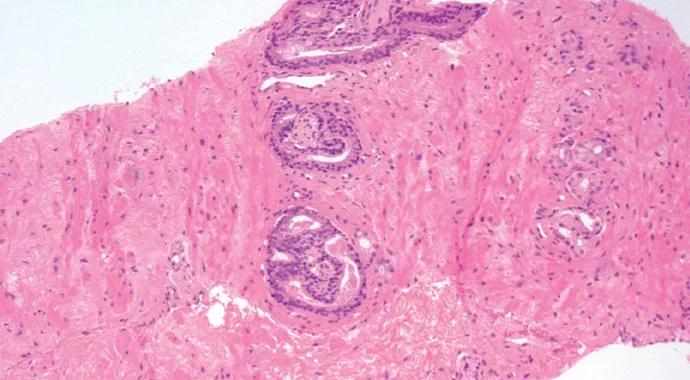Outcomes are no worse than curative therapy over follow-up as long as 6 years

Advertisement
Cleveland Clinic is a non-profit academic medical center. Advertising on our site helps support our mission. We do not endorse non-Cleveland Clinic products or services. Policy
In the era of screen-detected prostate cancers, about 50 percent of men diagnosed with prostate cancer (PC) have low-risk disease. The risk that these tumors pose to a man’s longevity and quality of life appears to be very low within approximately 15 years of diagnosis. Thus, active surveillance (AS) as a management option is especially appealing for patients with low-risk PC, given the uncertain benefit of treatment in terms of improving survival but the more certain impacts of treatment on health-related quality of life. Despite accumulating evidence attesting to its safety and efficacy, however, acceptance rates of AS in healthy men with long life expectancy are low.
Several studies support AS as a reasonable option in men with localized PC. It does not preclude desired disease-specific outcomes or the ability for cure. Approximately 30 percent of AS patients advance to definitive treatment, usually on the basis of Gleason score reclassification on repeat biopsy and/or changes in prostate-specific antigen (PSA) kinetics. Among AS patients who ultimately undergo definitive local therapy, PSA failure rates of less than 20 percent have been reported in most studies, which is comparable to the outcome of patients treated initially with external beam radiation therapy (EBRT) or radical prostatectomy (RP). A recent study of men older than 65 years with localized PC managed without initial curative therapy reported a 6 percent mortality rate from PC, which is substantially lower than that of historical controls. The risk of death from competing causes vastly outweighs the risk of death from PC for men on AS, lending support to AS as a relevant initial management option in this cohort.
Advertisement
There are no large studies comparing all-cause mortality and PC-specific mortality among patients managed with AS, EBRT, brachytherapy or RP. Active surveillance involves close monitoring with repeat biopsy to identify important cancers while they are still at a curable stage. In a randomized trial in men with clinically detected (as opposed to screen-detected) cancers, RP was associated with a 6 percent reduction in PC-specific mortality at 15 years (14.6 percent vs. 20.7 percent) and a 6.6 percent improvement in all-cause mortality (46.1 percent vs. 52.7 percent) compared with watchful waiting, which typically involves administering androgen deprivation therapy at the time of symptomatic local or distant progression, thereby differing from AS. However, in an unplanned secondary analysis, this benefit was restricted to men younger than 65 years Considering the 5- to 10-year lead time in diagnosis associated with screening, this result would translate to men with screen-detected cancer who are younger than 60 years.
The recently reported PIVOT trial, which involved 731 American men with screen-detected cancers in a similar trial design, reported no significant difference in all-cause mortality or PC-specific mortality at 12 years between RP and watchful waiting, No difference in all-cause mortality was observed in any of the subgroups analyzed, and only high-risk patients treated by RP had significantly lower risk of PC-specific mortality compared with watchful waiting. One would anticipate more favorable outcomes if men in these trials were managed by AS compared with watchful waiting, as treatment (when given) is administered with curative intent.
Advertisement
The impact of definitive local therapy vs. AS on all-cause mortality and PC-specific mortality for screen-detected cancers was analyzed in a contemporary, multi-institutional cohort of 12,910 patients, 12,458 of whom were treated by either RP (n = 7,672), EBRT (n = 2,467) or brachytherapy (n = 2,319) at one of two high-volume U.S. hospitals, and 452 managed by AS at a Canadian hospital. The median follow-up in the treatment and AS groups was 57 and 74 months, respectively, with 9 percent and 20 percent men with follow-up greater than 10 years. On multivariable regression analyses, AS was associated with a significantly reduced risk of all-cause mortality and no significant difference in PC-specific mortality compared with treatment. The increased rate of all-cause mortality associated with treatment was observed among patients receiving EBRT and brachytherapy but not RP. Similar results were observed when the analyses were restricted to men with minimal or no comorbidity and/or low-risk features at diagnosis.
A randomized trial with follow-up of at least 15 years is needed to definitively assess whether treatment for screen-detected PC significantly improves quantity and quality of life compared with AS. Our study provides further evidence that AS in appropriately selected patients with screen-detected PC is not associated with worse all-cause mortality or PC-specific mortality compared with definitive local therapy over a follow-up of 10 years, even among low-risk patients or those with minimal or no comorbidity. A surprising finding of our study was an increased rate of all-cause mortality in men treated by EBRT and brachytherapy, which appears to be the result of a significantly increased risk of death from competing causes.
Advertisement
The accumulating evidence from our study and others indicates that AS is an acceptable management strategy for low-risk patients and need not be restricted to those with limited life expectancy or a high probability of indolent prostate cancer.
Dr. Stephenson is Director, Center for Urologic Oncology at Cleveland Clinic’s Taussig Cancer Institute.
Advertisement
Advertisement

Historic collaboration connects two Cleveland Clinic locations, enables real-time sharing of metrics and surgical progress

Retrospective study evaluates clinical upstaging during neoadjuvant treatment

Retrospective study finds acceptable cancer control among most histologic subtypes with intravesical therapy

Revolutionizing pediatric urology with a new, less invasive approach

What updated techniques, counseling and a changing workforce could mean

Applications, outcomes and untapped potential

Retrospective study shows SGLT-2 inhibitors may lead to worse urologic outcomes

Early, individualized diagnosis and comprehensive management key to preserving fertility